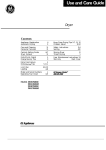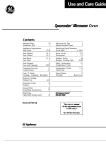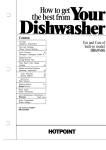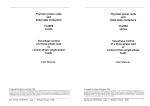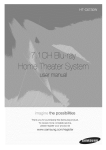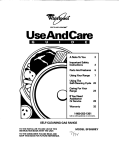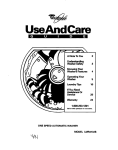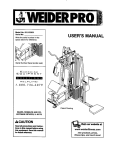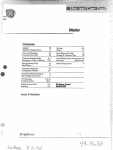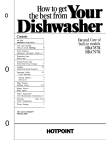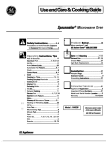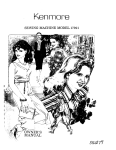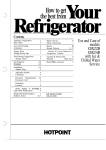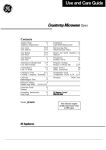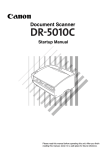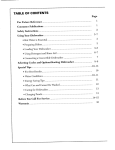Download GE Spacemaker WSM2400L User's Manual
Transcript
SpacemakerTMbundry
Contents
Appliance Registration
Care and Cleaning
2
25
Cautions
Controls Setting Guide
16
8,9
Repair Service
Safety Instructions
26
3,4
User Maintenance Instructions 25
Vacation Tips
25
Dryer
Automatic Drying
7
Controls
Dryness Selections
7
Agitator
Controls
End-of-Cycle Signal
Ener~-Saving Tips
7
7
Detergen@ Other Additives 11.15
Energy-Saving Tips
7
Knits Drying Tips
Lint Filter
7
7
Hard Water
Limestone Deposits
Operating Instructions
Perm. Press Drying Tips
7
7
7,23
Sorting
Timed Drying
5
Energy-Saving Tips
Front Access Panel
10
25
Model and Serial Numbers
Problem Solver
Model WSM2400L
7
2
18-24
Warranty
Washer
Back Cover
Lint Filter
Loading Clothes
Operating Instructions
Sorting
Stains
Stain Removal Guide
GEAmw Ge&
8M.~.~
25
6
14
12
6,25
6
6
5
16
17
Help us
help you...
Before usi~ your
SpacemakerTM Laundry,
read this book carefully.
It is intended to help you operate
and maintain your new appliance
properly.
Keep it handy for answers to your
questions.
If you don’t understand something
or need more help, write (include
your phone number):
Consumer Affairs
GE Appliances
Appliance Park
Louisville, KY40225
If you received a dam~ed
appliance . . .
Write down the model
and serial numbers.
You’ll find them on a label on the
inside of the door or the rating plate
on top of the dryer.
These numbers are also on the
Consumer Product Ownership
Registration Card that came with
your appliance. Before sending in
this card, please write these
numbers here:
Model Number
Serial Number
Use these numbers in any
correspondence or service calls
concerning your appliance.
FOR YOUR SA=TY
If you smell gas:
1. Open windows.
2. Don’t touch
electrical switches:
3. Efiinguish any
open flame,
4. immediately call
your gas supplier.
‘Don’t turn electric switches
on or off because sparb may
ignite the gas.
FOR YOUR SA=TY
Do not store or use
gasoline or other
flammable vapors and
liquids inthe vicinity
of this or any other
appliance.
Immediately contact the dealer
(or builder) that sold you the
appliance.
Save time and money.
Before you request service . . .
check the Problem Solver on
pages 18 through 24. It lists causes
of minor operating problems that
you can correct yourself.
All washing and drying instruction terms in this book conform to the
Care Labeling Rule established by the Federal Trade Commission, January 1984.
2
I
IMPORTANT SAFETY INSTRUCTIONS
Read all instructions before using this appliance.
W~IN&To reduce the risk
of fire, eleetric shock, or injury to
persons when using your apptiance,
foilow basic precautions,
including the following:
Use this appliance only for its
intended purpose as described in
●
this Use and Care Book.
● This appliance must be
properly installed and located in
accordance with the InstaBation
Instructions before it is used. If
Make sure that the cord is located
so that it will not be stepped on,
tripped over or otherwise subjected
to damage or stress,
● Do not repair or replace any
part of the appliance or attempt
any servicing unless specifically
mommended in this Use and Care
Book or in published user-repair
instructions that you understand
and have the skills to carry out.
To minimize the possibility
of injury:
appliance, you can obtain one by
contacting the service location
nearest you.
–Properly ground to conform
with all governing codes and
ordinances. Follow details in
Ins@llation Instructions.
–hate where the temperature is
above 50°F. (lO°C.) for satisfactory
operation of the control system.
Do not ins~ or store the appliance
where it will be exposed to the
weather.
–Connect to a properly rated,
protected and sized power-supply
circuit to avoid electrical overload.
–Exhausting to the outside is
STRONGLY RECOMMENDED
to prevent large amounts of moisture
and lint from being blown into the
room. Carefully follow the details
in the Installation Instructions, If
your appliance is not vented to the
outside, see special instructions
on page 25.
Do not mix chlorine bleach with
ammonia or acids such as vinegar
and/or rust remover. Mixing can
produce a toxic gas which may
cause death.
● When disconnecting this appliance pull by the plug rather than
the cord to avoid damage to the
cord or junction of cord and plug.
Never reach into w~her while
it is moving. Before loading,
●
you did not receive an Installation
instructions sheet with your
● Turn off water faucets when the
washer is not in use to relieve
pressure on hoses and valves, and
to minimize leakage if a hose or
valve should break or rupture.
hot water system may not have
been used for some time, turn on
aZZ hot water faucets and ~low
them to run for s~eral minutes
before using any eleetricd
appliance which is connwted to
the hot water system, This wiH
allow any hydrogen gas to escape.
Since the gas is flammable, do not
smoke or use an open flame or
appliance during this process.
●
● Do not wash or dry articles
that have been cleaned in, washed
in, soaked in, or spotted with
combustible or explosive substances
(such as gasoline, degreasers,
dry-cleaning solvents, kerosene,
etc.) which may give off vapors
that could ignite or explode.
Do not add these substances to
the wash water, and do not use or
store these substances on/or
around your washer and dryer
during operation.
● HYDROGEN GAS is produced
by the chemical action within
your water heater and the gas can
accumulate in the water heater
and/or water pipes if hot water has
not been used for a period of two
weeks or longer. HYDROGEN GAS
CAN BE EXP~SIVE UNDER
-E C~CUMSTANCM. So to
prevent the possibility of damage
or injury, if you have not used hot
water for two weeks or more, or
move into a residence in which the
unloading or adding clothes, push
the cycle selwtor knob in, then
wait until the machine has
completely stopped before
opening the lid.
Never reach into the dryer
while the drum is moving, Before
loading, unloading or adding
clothes, wait until the drum has
completely stopped.
●
● Close supervision is necessary
if this appliance is used by or near
children. Do not allow children
to play inside, on or with this
appliance or any disarded
appliance. Dispose of discarded
appliances and shipping or
packing materials properly.
Before discarding a washer or
dryer or removing them from
service, remove the lid or door.
● Keep all laundry aids (such as
detergents, bleaches, fabric sokners,
etc.) out of the reach of children,
preferably inalockedcabinet. Observe
all warnings on container labels to
avoid personal injury.
● Keep the floor around your
appliances clean and dry to reduce
the possibility of slipping.
-
3
I
1
I
m
■
1
1
i
!
.
■
m
i
1,
,I
i
1
i1
m
r
.
I
I
m
i
m
A
WORTANT S~ETY~STRUCTIONS (c.ntinu.d)
To minimtie the possibility
of electric shock, unplug this
appliance from the power supply
before attempting any maintenance
or cleaning (except the removal and
cleaning of the dryer lint filter).
NOTE: Pushing the washer cycle
selector knob in or turning the
dryer cycle selector to OFF does
N~ disconnect the appliance
from the power supply,
● ~ not tamper with controls.
●
● Do not operate this appliance
if it is damaged, malfunctioning,
partially disassembled, or has
missing or broken parts, including
a damaged cord or plug.
● Never climb on or stand on the
washer or dryer top.
Q Do not wash or dry fiberglass
articles in your appliance. Skin
irritation could result from the
remaining particles that may be
picked up by clothing during
subsequent use of the appliance.
To rnitie the pssibitity
of a fire hamrd:
● DO not use heat to dry articles
containing rubber, plastic, or
simihr materkds (such as padded
bras, tennis shoes, galoshes, bath
mats, rugs, bibs, baby pants,
plastic bags, ete.) as these
materials may melt or burn.
Also, some rubber materials,
when heated, can under certain
circumstances produce fire by
spontaneous combustion.
● Garments labeled “Dry Away
From Heat” (such as life jackets
containing tipok) must not be put
in your dryer-fire h=ard could
result.
●
DO
not wash or dry Nticles
that have been cleaned in, washed
in, soaked in, or spotted with
combnstibleorwplosive substance
(such as gasoline, degreasers,
drycleaning solvents, kerosene,
etc.) which may give off vapors
that couid ignite or explode. Do
not add these substances to the
wash water, and do not use or
store these substances on/or
around your appliance during
operation.
● Any article on which you have
used a cleaning solvent, or which
contains flammable materials
(such as cleaning cloths, mops,
towels used in beauty salons,
restaurants or barber shops, etc. )
must not be placed in or near the
dryer until dl traces of these
flammable liquids or solids and
their fumes have been removed.
There are many highly flammable
items used in homes such as:
acetone, denatured alcohol,
gasoline, kerosene, some household
cleaners, some spot removers,
turpentines, waxes, wax removers
and products containing petroleum
distillates.
● Clean the dryer lint filter
before each load to prevent lint
accumulation inside the dryer or
in the room. DO N~ OPERATE
THE DRYER WITHOUT THE
LINT FILTER ~ PLACE.
. The interior of the machine
and the exhaust duct connection
inside the dryer shodd be cleaned
periodically by a qualified
individual.
● Exhaust duct (see installation
instructions). Use only metal duct
inside dryer or for exhausting
dryer to the outside.
4
● Keep area around and
underneath your app~ance
free from the accumulation of
combustible matarials, such as
lint, paper, rags, chemicals, etc.
● Do not store items that may
burn or melt (such as clothing,
paper material, plastics or plastic
containers, etc.) on top of the dryer
during operation.
● The laundry process can reduce
the flame retardancy of fabrics. To
avoid such a result, the garment
manufacturer’s care instructions
should be followed very carefully.
Wr -her operation
● Do not leave washer lid up during
cycle, This will stop the spin action
and prevent completion of the cycle.
Dryer-applied
fabric softeners or
anti-~tic conditioners
You may wish tosoftenyour
laundered fabrics or reduce the
static electricity in them. We
reeommend you use either a
fabric softener in the wash cycle,
according to the manufacturer’s
instructions for those producb,
or try a dryer-added product for
which the manufacturer gives
written assurance on the package
that their product can be safely
used in your dryer.
Service or performance problems
caused by the use of these products
are the responsibility of the
manufacturers of those products
and are not covered by the warranty
of this appliance.
SAVE TWE
INSTRUCTIONS
How to sort the clothes
Sort by surface tetiure
Sort by color
from
from
from
LINT PRODUCERS—such as terry
toweling and chenille—give up lint.
LINT COLLE~RS—such as
man-made fibers and napped fabrics
like velveteen and corduroy—attract
lint, and must be dried separately.
For more information about lint
control, see page 21.
Normally, if you sort clothes
correctly for washing, you will
have properly sorted drying loads.
Here’s an additional suggestion for
good dryer load make up:
Sort by weight
from
from
Sort by fabric
It pays tocheckandpre-treat
before washing.
Separate
. Empty pockets, brush out cuffs,
zip zippers, snap snaps, hooks and
buttons.
● Do any necessary mending—
rips, hems, tears.
. Check all items for areas of heavy
soil or stain and remove stains.
from
For Stain Removal Guide, see
page 17.
● Turn Poly Knits inside-out to
minimize fabric surface damage.
from
Soaking-a good way to
loosen deep SO* and a.
A thorough soaking with detergent
or special soaking agent is another
way to remove heavy soils, embeddd
dirt and even some stains. For detied
information on how to soak in your
washer, see page 6.
from
mm.
For information on soaking
agents, see page 15.
. - .-oa
5
How to operate your clothes washer
WWmG—TO reduce the risk of fire, electric shock, or injury to persons,
read the IMPORTANT SA~TY INSTRUCTIONS before operating this appliance.
bad the washer properly
● Add accurately-measured
detergent to empty tub. See pages
11 through 13.
● Load clothes loosely. Dry clothes
level should be no higher than the
top row of circular holes in the wash
tub. Do not put clothes on top of the
agitator or wind them around it.
For best results, mix large items
with small ones. When washing a
single heavy item, such as a shag
rug or bedspread, add one or two
other pieces to balance the load.
Large items should be no more
than one-half of the total load.
Here is a typical full load:
2 double sheets 2 long-sleeve
2 pair trousers
shirts
2 standard
pillowcases
. To bleach the load, measure
liquid bleach according to directions
on container. After washer has filled
and agitated for several minutes, add
diluted bleach to the wash water.
How to use powdered bleach,
fabric softeners and other laundry
products is explained on page 15.
● Close lid. Washer will fill and
agitate but will not spin with lid
open. This washer has a Safety Lid
Lock. As a safety measure the lid
will be automatically locked during
the spin portion of each cycle. The
lid will automatically unlock about
30 seconds after the end of the spin
cycle. To open lid during spin cycle,
push Cycle Selector IN and wait for
lid lock to release, about 30 seconds,
before opening.
For your personal safety, never
reach into washer while parts are
moving. Always stop washer to
load, unload, add forgotten items
or additional laundry aids.
w:jte( level
Q
Set the controls
See the Controls Setting Guide on
pages 8 and 9.
~Select Washing Temperature.
Cold rinse will be automatically
provided with all cycles.
~Select Water Level.
SMALL: Washer is less than 1/3
full of clothes.
MEDIUM: Between 1/3 and 2/3 full.
LARGE: Over 2/3 full of clothes.
Self-cleaning lint filter. The lint
filter needs no attention from you.
Lint collected during washing and
rinsing of clothes is automatically
flushed down the drain.
~PullCycleSelector outto start
the cycle.
Note: If you have selected the Perm
Press or Regular cycle and wish to
change cycle setting after washer
has started, push Cycle Selector in
and wait for washer to stop. Then
reset to the new position. Setting
can be changed at any time during
the Perm Pr~ss or Regular cycle .-
Delicate cycle
PULL STAR
USH STOP
o
/f~%l&: !
How to soak in the washer
Set Washing Temperature control.
Add detergent or soak agent. Turn
Cycle Selector to desired cycle.
Start the washer. After washer fills
and begins to agitate, push in the
Cycle Selector to stop washer. Allow
to soak for as long as desired. After
desired soak, turn to the last Spin.
Pull out the Cycle Selector to
complete the cycle.
6
—... -.——.—
@Push Cycle Selector in and
turn clockwise to your selected
wash cycle.
/.
.$’:
r
ak. -
0
To get the full benefit of the
Delicate Cycle, always set it at
the beginning of the cycle. During
wash, the Delicate Cycle alternates
between agitation and pauses to
protect delicate clothes.
How to opemte your dryer
W~NING—To reduce the risk of fire, electric shock, or injury to persons,
read the ~PORTANT SA~TY INSTRUCTIONS before operating this appliance.
bad the dryer properly
● Load sorted clothes into dryer.
See page 5.
● Clean lint filter before each load.
timed
dry.
HIGH
automati(;
MEDIUM
delicate
air t.[uf-f’,
dry;rlg
LOW
...
NO
HEAT
temperature
o
push to start dryer
Q
Remove the lint filter by pulling
straight out. Wipe all accumulated
lint from screen. Occasionally
wash filter using soap and warm
water. Rub lightly, rinse and dry
thoroughly. This will help remove
all fabric softener buildup.
Do not use dryer-applied fabric
softeners unless you follow these
lint cleaning instructions.
Do not operate dryer without lint
filter in place.
● Close door. Door must be closed
before dryer will operate.
Set the controk
See Controls Setting Guide on
pages 8 and 9.
OTurnCycle Selector clockwise
to desired cycle and select correct
drying time for load type.
~PressPushto Start button.
(Opening door during operation
stops dryer. To re-start, close door
and press Push to Start button again. )
Buzzer sounds briefly to alert You
when cycle is compl;ted. -
Dryness Selections Guide for the Automatic Cycle
&t to
Middle
Set toward
MORE DRY
&
.
,% .:,7 :
/+%<<06,’,,!:’
F
-.< .J
●
For most normal loads.
include heavyweight fabrics.
● If you desire to remove more moisture.
● For
loads that
o
Set toward
LESS DRY
● For lightweight fabric loads.
~ ;:;$
-F
● For very small loads. (Add two or more similar
‘ .Ut(,% .%>~
e,
articles, even if dry, to assist tumbling. )
T
“’e ~-o
● If you desire to remove less moisture.
o
7
~lyester Mti &
Rrm mess Drying ~ps
. ~ not overload—Garments
being dried or dewrintied should
tumble freely.
● Remove cloth= immediately—
To help prevent writiing, remove
from the dryer immediately at the
end of the drying cycles.
● Place on hangers-Permanent
Press and Polyester bit garments
look best if placed on hangers after
drying.
How ~ed and Automatic
Drying Differ
Automatic drying-The Automatic
Dry Control system continually
senses air temperature in dryer
drum. Wet laundry keeps this air
cool. When drum air is warm
enough, heat turns off. When the
air cools, heat turns back on. This
on and off cycling may happen a
number of times (depending on the
fabric, load size and Cycle Selector
setting). The Cycle Sel=tor advances
(when the heat is of~ until it
automatically turns dryer off.
Timed drying—You select the
number of minutes you wish the
dryer to run and it turns off at
the end of this time period.
Controk Setting Guide for different fabrics and loads
Washer
Type of had
Baby Clothes
Plastic-1ined items
Diapers
Man-made fabrics**
Mixed cottons
Wash Water
Wash
Wash Cycle
Temperature
Cycle
Setting
Warm
Hot
Delicate*
Regular
Set at START.
See #l below.
Air Fluff (No Heat)
Timed Dry (High Heat)
Warm
Warm
Delicate*
Perm Press
Set at START.
See #2 below.
Delicate (Low Heat)
Automatic Dry (Medium Heat)
I
Beds~reads
Blanke@
Electric
Man-made**
Woolen
Cottons & Linens
Colorfast/White
Non-Colorfast
Curtains
Cotton
Man-made~* Sheers
Permanent Press
Delicates
Foundation GarmentsT
Glass Fiber
Permanent Press
Curtains
Dramries
Dresses, sportswear
Heavy slacks
Knits. man-made**
Lingerie
Sheets & pillowcases
Work clothes
Plastic
Quilted Items
Swimsuits
Sweaters. man-made fabrics**
Synthetic Sheets
Washable Woolens
I
Dry
Cycle
I
I
Follow Label Directions.
I
I
Warm
Warm
Warm
I
Delicate*
Delicate*
Delicate*
I
I
Set at START.
Set at START.
Set at START.
I
Hot
Warm
Regular
See #l below.
Timed Dry (High Heat)
Hot or Warm
Warm
Warm
Regular
Delicate*
Perrn Press
See #1 below.
Set at START.
See #2 below.
Timed Drv (High Heat)
Delicate (Low Heat)
Automatic Dry (Medium Heat)
I
I
Delicate*
I Set at START.
Do not wash glass fiber in the washer.
Warm
I
I
Delicate (Low Heat)
Delicate (Low Heat)
Delicate (Low Heat)
Warm
Warm
Warm
Hot
Warm
Warm
Hot
Perm Press
Delicate (Low Heat)
See #2 below.
Automatic Drv (Medium Heat)
Hot
Warm
Delicate* I Setat
START.
Perm Press
See #2 below.
Perm Press
See #2 below.
Set at START.
Delicate*
Delicate*
Set at START.
Perm Press
See #2 below.
See #2 below.
Perm Press
See #2 below.
Delicate*
Set at START.
I Automatic Dry (Medium Heat)
Automatic Dry (Medium Heat)
Automatic Dry (Medium Heat)
Delicate (Low Heat)
Delicate (Low Heat)
Automatic Dry (Medium Heat)
Automatic Dry (Medium Heat)
Automatic Dry (Medium Heat)
Air Fluff (No Heat)
Warm
Warm
Warm
Follow Label Directions.
Follow Label Directions.
Delicate*
I Set at START.
Delicate*
Set at START.
Delicate*
Set at START.
I
I
I
Delicate (Low Heat)
Delicate (Low Heat)
Delicate (Low Heat)
I
Work Clothes
Hot
Regular
See #l below.
Timed Dry (High Heat)
fl Regular Cycle: 1O-K minutes for Heavy soil, 5-10 for Normal soil, up to 5 for Light soil.
#2 Perm Press Cycle: U minutes for Heavy soil, 48 for Normal soil, up to 4 for Light soil.
*Delicate cycle alternates between pauses and agitation during wash.
**Man-made fi~rs (~ntietics) such as polyester, nylon and acrylics must be dried using the Delicate (low heat) Cycle. If you mlX VariOus tYPes of
fabrics in your drying load, set the controls for the lightest weight fabrics and remove when dry. Then reset the control for the remaining fabrics.
~Never dry foam rubber or similarly textured, rubber-like materials in the dryer except on AIR FLUFF (no heat). Fire hazard may result.
8
Save and refer to Garment Manufacturers’ Care bbels
For more information on care labeling, send for “What’s New About CARE LABELS:’
For sale by the Superintendent of Documents, U.S. Government Printing Office, Washington, D.C. 20402.
Dryer
Dry Cycle
Setting
Special Instructions
up
I
to 20
45-60
Plastic-lined pants, bibs, pads, crib sheets may be washed with regular load but should be dried separately.
I Rinse at once, soak indiaperpail with solution of cold water and borax (Iti teaspoons to gallon). Soak before
washing with a presoak p~oduct. Use warm water.
25-40
Midpoint
Pretreat heavily soiled areas; brush on a little liquid detergent, or wet area and rub in detergent. Use Warm
Soak for oil and iuice stains: cold for e~~. milk and cereal stains.
Follow Label Directions.
u“,
85-95
65-95
15
Shake out excess dust. Remove stains. Pretreat heavily soiled areas with detergent. Wash one large or two
small blankets at a time.
1
See “Washable Woolens” instructions below.
Full loads 65-75
Small loads 35-45
If badly sun-weakened, even hand washing will cause tearing. Be sure colors are fast and fabric is washable.
Remove hooks and non-washable trim. Use Warm Soak if heavily soiled,
*
30-40
1
I
I
Less Dry
Midpoint
MidDoint
,.
More DN
25-35
20-30
Midpoint
Midpoint
More Dry
15-20
40-55
15-20
5-15
Frequent washing lengthens life, helps retain shape. Remove non-washable trim. Close zippers; fasten hooks.
Do not dry glass fiber in the dryer.
If badly sun-weakened, even hand washing will cause tearing. Be sure colors are fast and fabric is washable.
Remove hooks and non-washable trim. Use Warm Soak if heavily soiled.
1
Turn slacks and dark items inside out to Drevent whiteninp of seams and creases.
I
Use Warm Soak for pillowcases stained with hair oil.
Pretreat collars and cuffs with liquid laundry detergent.
I See ’’Work Clothes” instructions below.
Some plastics will tear if machine washed. Place small items in mesh bag for washing. If shower curtains are
soap-streaked, add Calgon brand to wash water; don’t use detergent.
Follow Label Directions.
Follow Label Directions.
Pretreat around neckline. Follow manufacturer’s recommendations.
,
65-85
As a general rule, if wool can be hand washed, it can be “washed” by soaking in the washer. A liquid
detergent is preferred because it dissolves faster in a soak than a granulated detergent. Pretreat woolens with
Iiauid detergent. Never use chlorine bleach.
Pretreat heavily soiled areas by rubbing in liquid laundry detergent. Let sbnd 30 to 60 minutes. If clothes are
heavily soiled, use Warm Soak for greasy and oily soil. Cold Soak for flour, dust, blood-stained garments.
Use 1/4 to 1/2 cup liquid laundry detergent in SOAK; l/2 to 1 cup in Wash.
DO NOT tumble dry jackets or pillows containing Kapok. Fire hazard may result.
NOTE: The Cycle Selector settings indicated here are to be used as a guide. You may find that best results are obtained for some of your fabrics by
setting the Cycle Selector to either side of the recommended settings.
9
Ene~y-savi~ tips
If your clothes and household items
don’t look clean and fresh after
washing, you will probably re-wash
them... and that means you’ll waste
energy. Remember to sort your
clothes carefully, and load them
properly, select correct cycles, use
enough detergent and choose a
water temperature warm enough to
release and get rid of soil.
Use H~ wash—140°F. (60°C. )—
on a ~~ar basis only when washing
heavily soiled articles-such as
work and play clothes.
●
● Under normal soil conditions,
wash in water above 80°F. (~°C.).
This generally means using the
WARM wash temperature setting
on your washer—temperatures
approximately 95°F. (35°C. ). If you
notice that soil has accumulated
after several consecutive washings,
use HOT wash occasionally, if safe
for fabrics.
● Always rinse in COLD water.
The temperature of the rinse does
not affect cleaning.
● Sort clothes by weight so you won’t
have to run an extra cycle for one or
two heavier, slower-drying items.
. Do not overload dryer. The drum
should be no more than half full of
wet articles. For efficient drying,
clothes need to tumble freely.
Overloading prolongs drying time
and produces uneven drying.
● Use Automatic Drying Cycle
whenever possible to help prevent
overdying and save energy.
● To help prevent ironing, remove
garments immediately at end of
drying cycle and place on hangers.
● Dry your clothes in consecutive
loads. Using a “warm” dryer will
save energy.
●
Clean lint falter each time you dry.
● Clean dryer exhaust ducting
at least once a year. A partially
clogged exhaust can lengthen
drying time.
● Try to wash less ofien. Save
articles of the same type of fabric
until you have a full load.
● If you must wash smaller loads,
adjust the amount of water. Small
loads should have lower water
levels.
. Wash in off-peak utility hours.
Your local utility can tell you which
are the off-peak hours.
10
Factors to consider in selecting detergenk and soap
Produck
Advantages
Phosphate—
Powdered Detergents
Perform well in hard or soft water
—
Disadvantages
Are not available in some areas.
.
Wash all types of fabrics well.
Can be used in hot, warm, or
cold water.
Non-Phosphate—
Powdered Detergents
I
Perform satisfactorily in soft
or moderately hard water.
Generally do not clean well in
hard water.
In some areas only non-phosphate
products are available.
May be difficult to dissolve,
especially in cold water.
Should not be used in cool water.
Those containing sodium
carbonate as an ingredient may
cause harmful limestone deposits
on clothes and washer when
combined with hard water.
(Seepage 12.)
I
Liquid Detergents
Perform well in soft water.
Offer better performance in
hard water than powdered
non-phosphate types.
May not perform as well as
powdered phosphate products
when diluted in wash water.
Cleans synthetics and fabric
blends well.
Are excellent as concentrates
for removing spots.
Completely dissolve even in
cold water.
Soaps
Perform well in soft water.
Generally do not clean well in
medium-hard or hard water.
May combine with water
hardness minerals to form
sticky soap curd.
I
11
The resulk of continued use of carbonate
Is your water hard? If it is, and
if you use a carbonate type nonphosphate detergent, you will
most probably notice limestone*
depo;its on your clothes and
washer surfaces. The hardness
of your water and your washing
frequency will determine how
rapidly the limestone will build
up. If ~our water is VERY HARD
(11 or more grains) and if you wash
just a few loads a week, you may
see limestone buildups in just a few
months.
Effec@ on clothes
Recommended methods to
tiuce hestone btidups
● Increase use of blwches, presoaks,
packaged water conditioners, prewash
soil and stain removers to help in
removing stubborn soils and stains.
Although limestone buildup occurs
more rapidly on cotton, it will
eventually affect various fabrics in
the following ways:
● Gives a stiff, harsh, rough feel to
fabrics such as toweling.
● Causes colors to fade and become
dull and dingy.
. Causes graying of fabrics.
c Leaves a white, powdery residue
on dark-colored items.
c Causes spot-fading of bright
colors as a result of direct contact
with detergent.
Reduces wrin~e-resistance of
permanent press fabrics.
●
● Destroys effectiveness of flameretardant finishes on cottons such
as children’s sleepwear.
. Increases fabric wear because
of the scrubbing action between
limestone deposits on the fabrics
during washer agitation.
~-on washer
● Use a powdered phosphate
detergent or a liquid detergent if
these are available in your area.
. Install a home water softener.
This will significantly reduce
limestone buildup.
. Use a packaged non-precipitating
water softener, such as Calgon
brand with phosphate.
M was~ practice
may deky h~ne dam~e
to cloth=
The following recommendations
will temporarily delay the effects
of limestone on your clothes.
These are generally good washing
practices and will give better soil
removal whether or not you have
hard water or use carbonate
detergent.
● Use hotter wash water, for
example up to 150°F. for cottons.
This also improves oily-soil
removal.
If you wash in cooler water to
save energy, use more detergent to
promote better washing. Also be
sure to use bleach on bleachable
fabrics. Use hot water whenever
possible.
●
. Unsightly buildup on all washer
surfaces exposed to the wash
solution.
● Mat-like, crusty formations caused
by lint adl~ering to the sticky
limestone deposits.
. Increased service calls because
of limestone deposits in the pump,
recirculation water hoses, filters
and other washer parts.
●
Reduced useful life of washer.
● Use greater care in sorting loads.
Wash very dirty loads separately
and increase detergent to help keep
dirt from redepositing on less
soiled items. Wash delicate items
separately to prevent damage from
heavy, sturdy clothes.
c Wash smaller loads to increase
cleaning action of washer.
s Use fabric softener to counteract
stiffness or harshness in clothes.
How to partially restore clothes
Once clothes have developed
deposits, they may be partially
restored by soaking in a solution
of two cups of vinegar in one gallon
of hot tap-water for-15 minute;.
USE A PLASTIC CONTAINER.
Then wash clothes in the washer
using detergent.
CAUTIONS:
c Vinegar soak solution may
reduce the wrin~e-resistance
of permanent press fabrics.
● Vinegar soak may damage
the dyes in some fabrics.
. Add detergent and allow washer
to fill and agitate for three or four
minutes to dissolve detergent
before adding clothes.
. Increase amount of detergent.
See guide on opposite
page for
..
recommended detergent amounts
in relation to water hardness.
*LIMES~NE—technically called CALCIUM CARBONATE—is caused by the
reaction of the calcium in the hard water with the sodium carbonate in the detergent
12
How much dete~ent should you use?
The use of a sufficient amount
of detergent is one of the most
important things you can do to
make sure your wash comes out
clean.
hount required varies
according to:
1. Water hardness
2. Amount of soil
3. Size of load
4. Type of detergent
5. Wash temperature
Use more detergent if
you have. . .
1. Hard water
2 Large loads
3. Greasy or oily soils
4. Lower wash temperature
5. Low uhos~hate detergent.
If the recommended amount of
detergent produces too many suds,
switch to a low sudsing detergent
brand, and follow instructions on
package. Excess suds are not
necessary to get clothes clean
and can hamper wash action.
Using too little detergent is a common
cause of laundry problems. Always
measure detergent in a standard
measuring cup.
How to use granular or powdered
detergent.
For best results, put the detergent
in the washer before the clothes
have been loaded.
If your detergent doesn’t dissolve
well, pre-dissolve the detergent in
hot water and put it in the washer
before clothes are added.
U9
‘\
~
Recommended amount of detergent for average soil load
1. Use recommended amount of
detergent for your load and water
Water Uvel Setting
POWDERED
DETER{;ENTS
CONCENTRATES
AND
LIQUIDS
Water
Hardness
VERY
HARD
10-20 Gr.
HARD
4-10 Gr.
SOFT
O-4 Gr.
0-20
Grains
LARGE
MEDIUM
SMALL
1 M cups
I M cups
% cup
1 % cups
[ cup
% cup
1/2
1/2
cup
cup
1A cup
hardness as shown in guide.
2. When using other detergent
types-low and normal suds, powders,
liquids, non-phosphate powders—
follow recommendations on package.
3. For hard water treatment, see
page 14.
I’OLI,OW PACKAGE DIRECTIONS
13
Hard wakr
Before you can decide what to do
about hard water, you need to how
if you have it and, if so, how hard
it is.
● If you live in a municipal area,
contact your water company.
● If you live in a rural area, or in
some suburban areas, contact your
county agent.
The answer will be “you have ‘so
many grains’ per gallon” and
means this:
O to 3 grains per gallon–SOFT
4 to 10 grains–HARD
11 to 19 grains–VERY HARD
20 grains and over—
EXTREMELY HARD
If your water is SOFT, you have
no problem. You can use soap or
detergent as you prefer and forget
all about hard water. If you have
HARD water—less than 10
grains—and you use phosphate
detergent, you also have no
problem.
But, if you have more than 10
grains, you will need to soften your
water with either . . .
1. An installed water softener in
your home, or
2. The use of a pacbged water
softener.
For information on water
softeners, see chart below.
Add t~ much water w~ner tith a M water l~el
Grains of
hardness
When using
with detergent
When using
with soap
o–lo
1O–B
15–20
20–25
25–30
o
1A cup
(60ml)
Ih cup
(120 rrd)
2h cup
(160 d)
1 cup
(240 ti)
1A cup
(80 ml)
Zh cup
(160 ml)
% cup
(180 ml)
1 cup
(240 ml)
1% cups
(360 ml)
14
over 30
1 cup plus 1 ~blespoon for eve~ 5 grains
above 30 (240 ml plus 15 d for each
extra 5 grains)
lK CUPS PIUS 1 tablespoon for eveu 5 groins
above 30 (300 ml plus 15 ml for each
extra 5 grains)
Other laundry produck—
Laundry
hduct &
How to use it
Spcial Instruction
BLEACH
Chlorine liquid
such as Clorox’” brand
Dilute one cup bleach with at least one
quart (0.96 liter) water and add after
wash action has started and detergent
is dissolved.
1) Do not pour undiluted liquid chlorine bleach directly
into washer or on dry clothes.
2) Some of today’s washable fabrics should not be chlorine
bleached such as: 100% cotton flame-retardant children’s
sleepwear, silk, wool, mohair, spandex, leather, or non-fast
colors. Dilute bleach before using on any fabric.
3) Check manufacturer’s hang tags for special instructions.
Non-chlorine such as
Clorox 2“” brand
Follow package directions.
Put bleach into washer with detergent.
1) May be used on all kinds of fabrics.
2) Is most effective in hot water.
Mix recommended amount with one cup
(240 ml) water and add at start of rinse
cycle.
1) Helps make clothes fluffy and soft.
2) Reduces static electricity.
3) Use carefully. Too much may cause staining on some
clothes.
4) Do not use with other laundry additives.
5) Do not pour directly on the clothes.
Wash additive
such as Rain Barrel’”
brand
Follow package directions.
Add during wash cycle.
Use carefully. Too much may cause staining on some
clothes.
SANITIZER
Chlorine bleach, such
as Clorox’” brand
Use in case of infection and
contagious disease.
See under Bleach above.
Guards against infection by killing most bacteria
and viruses~
WATER SOFTENER
Non-Precipitating
such as Calgon’” brand
Follow package directions.
Add at stirt of wash cycle.
Suspends hardness minerals in solution, keeping
water clear.
Follow package directions.
Use with detergent or soap in
wash cycle.
Combines with water hardness minerals to form
precipitate which gives cloudy or milky appearance
to water.
SOAK AGENT
Such as Biz’” brand
Follow package directions for grass,
perspiration, egg, baby formula,
blood, mud and other stains.
Do not use with chlorine bleach as chlorine stops the stain
removal action of enzyme soak agents.
PRETREATING
STAIN AND SP~
REMOVERS
Such as
Spray ‘n WashT”
and K2RT” brands
Follow package directions. Treat
only heavily soiled areas. Check
garment’s hang tag for instructions.
CAUTION: Control panel and finishes may be damaged by
some laundry pretreatment soil and stain remover products
if such products are sprayed on or have direct contact with
the washer and/or dryer. Apply these pretreatment products
away from the appliance. The fabric may then be washed
normally. Damage to your appliance caused by pretreatment
products is not covered by your warranty.
TINTS AND DYES
Powdered such as
RitTM and Tintex’” brands
Follow package directions.
N~E: Tinted garments may not be
colorfast. Wash separately.
Clean washer to avoid discoloration of next load. Go
through complete qcle (5-mirr. wash) using hot water,
1/2 cup (120 ml) detergent, 1 cup (240 ml) bleach. Wipe
exterior parts. Caution: Tinting may discolor plastic in
washer. Subsequent washings will reduce discoloration
but may never eliminate it.
FABRIC SOFTENERS
Rinse additive such
as DownyT” brand
Precipitating such as
BoraxT” brand
*For more information on sanitizers, send for Government Bulletin #57B, “Sanitation in Home Laundering?’
Write to: Consumer Information Center, heblo, Colorado 81~.
15
How to remove stiim
1. Try to remove stains as soon as
possible. The fresher the stain, the
easier it is to remove.
2. Before attempting to remove
any stain, take these steps:
. Find the fabric and the finish in
the guide on the next page, and use
only recommended methods.
● Check the care label instructions
that came with the garment.
● Test stain removal product on a
hidden inside seam or on a sample
of the material.
● Avoid use of hot water on
unknown stain. It can set some
stains.
3. Follow stain removal with a
thorough rinsing.
4. Wash with recommended
amount of soap or detergent.
Stain removal hint—
Using chlorine bleach for
white and bleachable fabrics.
Mix 1/4 cup (60 ml) chlorine
bleach with one gallon (3.8 liter) of
cool water—approximately 80°F.
(~°C.)–in a sink or pan. Soak
stained area for 5 minutes and
launder in washer.
bpotint Cautiom
● N EVER
PUT
HIGHLY
VOLATILE
SUBSTANCES LIKE GASOLINE,
KEROSENE, OR NA~HA IN~ A
WASHER OR DRYER.
N EVER
PUT
WASHABLE
ARTICLES
THAT HAVE GASOLINE, KEROSENE,
N~ OR ~R ~GHLY VOLA~E
SUBSTANCES ON THEM IN A WASHER
OR
DRYER. FAILURE
TO
COMPLY
WITH THESE WARNINGS COULD
RESULT IN A FIRE, EXPLOSION OR
SENOUS BODILY INJURY. All items
with volatile substances on them
should be ~ washed thoroug~y
with a detergent so that no trace of
volatile substance remains. The
articles can hen be machine washed.
Only after thorough hand washing
and machine washing should the
article be placed in the dryer.
The Case of the “Invisible” Stain.
Food or cooking oils on your
synthetic garments may cause stains
which are virtually invisible and
which you may not notice as you
put your clothes into the washer.
If these stains are not completely
removed in the wash, the oily spots
may pick up dirt from the wash
water. Then they will become very
visible and you may think they were
caused by the wash cycle itself.
Once these spok become visible,
how can you remove them?
● Rub in undiluted liquid detergent
and let stand 30 minutes.
. Re-wash using hottest water the
fabric can stand.
How can you prevent these
“After-You-Wash” shins?
● Increase the amount of detergent
normally used.
● Increase water temperature where
fabric will permit.
. Wash synthetic garments more
often.
Do not use these substances around
your washer and/or dryer during
operation.
*Because cleaning fluids tend to
be toxic, be sure you are in a well
ventilated room when using them.
No cleaning fluid should be used
unless user is familiar with the
limitations and required cautions
(usually printed on label). Use
extreme caution with flammable
compounds. Under no circumstances
should fabrics containing flammable
materials (waxes, cleaning fluids,
etc. ) be washed in washer.
**DO not mix chlorine bleach with
ammonia or acids such as vinegar
and/or rust remover. Mixing can
produce a toxic gas which may
cause death.
16
See next page for
Stain Removal Guide.
For more complete information on
stain removal, request government
bulletin, “Removing Stains From
Fabrics,” 054D. To obtain a copy
write to: Consumer Information
Center, Pueblo, Colorado 81009.
Available at low cost.
Shin removal guide SaveandrefertoGarmentMan"facturem'CareInstr"ctions.
Stain
White and Bleachable Fabrics
See Washing Guide, Bleach on page G
Other Washable Fabrics
Adhesives
(Chewing Gum, etc.)
Rub with ice or immerse in very cold water. Use dull tool to
carefilly scrape off as much adhesive or gum as possible. Sponge
with a safe dry cleaning fluid,* then launder.
Same as white and bleachable fabrics.
Anti-perspirants,
Deodorants
Apply undiluted liquid detergent. Rinse. If stain remains, bleach
according to Stain Removal Hint on opposite page. If color has
changed, you may be able to restore it by sponging with
ammonia.** Rinse thoroughly.
Same as wbite and bleachable fabrics
except use non-chlorine bleach.
Blood
Soak in cold water, then launder in warm water. If stain remains,
bleacb according to Stiin Removal Hint on opposite page, launder.
Sponge or soak in cool water, then launder.
Chocolate, Cream,
Ice Cream and Milk
Soak in cold water. Treat stain with a safe dry cleaning fluid*;
Apply undiluted liquid detergent, launder, dry. Bleach according
to Stain Removal Hint on opposite page, launder and dry.
Soak in cold water. Sponge with a safe dry
cleaning fluid.* Apply undiluted liquid
detergent. Launder in warm water.
Coffee and Tea
Without cream: Bleach according to Stain Removal Hint on
opposite page. Launder. With cream; Follow guide directions for
cream.
Sponge with warm water. If stain remains,
apply warm glycerine, let stand 30 minutes
and rinse well, or sponge with a safe dry
cleaning fluid.* Launder.
Cosmetics: Eye Shadow,
Lipstick, Mascara, Liquid
or Pancake Makeup, Rouge,
Powder; Crayon; Grease,
Oil, Tar, Cod Liver Oil.
Treat stain with safe dry cleaning fluid* Apply undiluted liquid
detergent; launder and dry. Bleach according to Stain Removal
Hint on opposite page.
Sponge with a safe dry cleaning fluid*
Then launder in warm detergent water.
Fresh Fruit, Fruit Juices,
Wine, Vegetables, or Food
Coloring
Soak stain in cool water. If stain remains, bleach according to Stain
Removal Hint on opposite page, launder.
Sponge with warm water. Bleach remaining
stain with non-chlorine bleach.
Grass, Foliage, Flowers,
Mildew. Scorch
Apply undiluted liquid detergent. Launder. (Treat mildew spots
while they are fresh, before mold has a chance to weaken fabric. ) If
either type stain remains, bleach according to Stain Removal Hint
on opposite page, launder. (Severe scorch cannot be removed. )
Sponge with warm water. Apply undiluted
liquid detergent. Bleach remaining stain
with non-chlorine bleach, then launder.
Old mildew stains can seldom be removed.
Scorch can seldom be removed.
Ink, Ballpoint
Fresh stains: Place stain face down on an absorbent towel and
sponge with dry cleaning fluid? or use spray cleaner. Apply
undiluted liquid detergent. Old stains; bleach according to Stain
Removal Hint on opposite page.
Same as white and bleachable fabrics
except launder using non-chlorine bleach.
Paint and Varnish
Soften with oil, lard or Vaseline, then sponge with turpentine or
banana oil. Launder in warm water.
Same as white and bleachable fabrics.
Perspiration
Apply undiluted liquid detergent and launder in warm water, If
color has changed you may be able to restore it by treating with
ammonia or vinegar.** If any stain remains, treat with safe dry
cleaning fluid* or bleach according to Stain Removal Hint on
opposite page, launder and dry.
Launder in warm water. Rinse well. Bleach
with non-chlorine bleach.
Rust
Apply rust remover7* using manufacturer’s directions. Rinse and
launder.
Same as white and bleachable fabrics.
17
m
~“
Questions?
Use This Problem Solver
PROBLEM
WASHER OR DRYER
WON’T START
POSSIBLE CAUSE AND REMEDY
Make sure controls are properly set and washer cycle selector is pulled out or dryer
START button is pushed.
●
G Appliance unplugged. Make sure cord is firmly plugged into electrical outlet.
● No power to appliance. Check fuses and circuit breakers to make sure appliance is
getting current.
● Dryer door is open. Dryer will not run with door open. Make sure washer lid is closed.
Washer will fill but will not spin with lid open.
. Make sure both hot and cold faucets are turned on.
WON’T DRAIN
WATER LEAKS
●
Kinked or pinched hose. Check and correct.
●
Top of drain outlet should be less than 8 feet above the floor.
●
Make sure hose connections are tight at faucets.
●
Make sure end of drain hose is correctly inserted into and secured to drain facility.
WASHER WON’T
SPIN AND
COMPLETE CYCLE
●
CL~HES ARE
ABNORMALLY
WET AFTER SPIN
● Load may have been excessively out of balance. Redistribute clothes and rerun through
final spin.
APPLIANCE IS
NOISY
. Metallic “clicks” heard as timer advances during operation are normal.
Lid not closed. Washer will not progress through spin cycle with lid up. Make sure lid
is closed. Lid will be automatically locked during spin portion for safety.
●
Uneven floor. Make sure appliance is level and firm to floor.
● Heavily unbalanced loads can cause the washer to vibrate excessively during spin, and
may cause it to move from its original position. In extreme cases, (usually occurs when
washing a single, heavy item or a small load when water level is set higher than
necessary) the spin basket may strike the outer tub, creating aloud but harmless noise.
To correct, open the lid and redistribute the load evenly about the wash basket. Close the
lid and restart.
WATER DOES N~
ENTER OR ENTERS
SLOWLY
●
Faucets turned off. Make sure faucets are on and adjusted correctly.
. Hoses kinked. Check and correct.
● Clogged screen in water valve. Unscrew fill hose from washer and clean screen if
necessary. When reassembling, make hand tight plus 1/3 turn with pliers.
PROBLEM
POSSIBLE CAUSE AND REMEDY
WATER
●
TEMPERATURE
INCORRE~
Faucets not adjusted to give desired temperature. Readjust them.
Q Household water heater not set to deliver correct temperature—140° to HO°F.
(60° to 66°C.). Reset it.
. Water valve screens may be stopped up. Remove inlet hoses from water valve. Clean
the screens and reinstall the hoses.
Q Make sure selector controls are properly set.
Q Make sure hoses are connected to correct faucets-hot to hot, cold to cold.
WASHERPAUSES
INCYCLE
● Washer normally pauses about 1/2 minute in progressing from one portion of its cycle
to the next.
Q Alternate pauses in the agitation are normal in the delicate wash cycle. Agitation will
resume in 1-2 minutes.
s The brief pause in the final spin of each cycle is normal operation for this washer.
GREASY OR OILY
STAINS ON
LAUNDERED
GARMENTS
YELLOWED
CL~HES
These are sometimes called “Invisible Stains” because you may not notice them before
washing clothes. However, if oily soils are not completely removed in wash cycle, the
oily spots may pick up dirt from the wash water. The spots will then be very visible.
They are not caused by the washer. Wash synthetic garments as soon as possible after
wearing. Use more detergent than normal and hottest water fabric can stand. If spots
appear, rub in undiluted liquid detergent, let stand 30 minutes and rewash with extra
detergent using hottest water fabric can stand.
● Incomplete removal of body soil due to constant use of insufficient detergent. Check
hem of T-shirt or pillow case. If they are white and center is yellow, it contains body
oil. Restore whiteness following procedures on “Grayed Clothes;’ page 20.
Q Chlorine bleach may yellow some fabrics with resin finishes. Use oxygen bleach
(such as Clorox 2 brand). Refer to garment manufacturers’ care instructions. Restore
color using color remover (such as Rit or Tintex brands), follow package directions.
●
Iron or manganese in water may cause overall yellowing or yellow spots.
1. Use extra detergent plus a non-precipitating water softener dissolved in water
before adding clothes. Use non-chlorine bleach.
2. Have a special filter or chemical feeder installed in your home to remove iron and
manganese from water.
3. Run hot water for a few minutes to clean iron residue buildup in lines; drain water
heater occasionally.
4. To remove spots: spread stained portion over pan of boiling water and squeeze
lemon juice through stain. To remove overall yellow, use a commercially available
rust scale remover, following package instructions.
The Woblem Solver (continued)
PROBLEM
POSSIBLE CAUSE AND REMEDY
BLUE OR GWY
COLOR STA~S
. kproper use of fabric sofiner. Never pour fabric sokner directly on clothes;
rdways dilute before adding to rinse water. To remove stiins: dampen stained area and
rub with undiluted liquid detergent. Re-wash, using chlorine bleach if safe for fabric.
GRA~D
CL~HES
● Insufficient detergent. You may need to increase the amount of detergent used, if the
load is larger than normal, if soil is heavier than average (especially oily soil), if water
level is high, or if water hardness is above average.
● Water is not hot enough for type of load. Make sure water heater is set to deliver hot
water at the washer 140°- EOT. (60°- 66°C.). Do not wash when other hot water
needs-such as dishwashing or fatily baths—are heavy.
. Poor or inferior detergent (or use of soap in hard water). Change to phosphate
detergent if possible.
Follow these steps:
Use water conditioner (such as Calgon brand).
c Use hottest water possible.
● Pretreat stins.
● Use bleach where possible.
● Use presoak aids.
Q Instil water sofiener.
● Washer overloaded. Clothes cannot move freely to loosen and remove soil, causing
gray appearance. Follow correct loading procedures for size of load.
●
● fmproper soaking, with insufficient detergent. Usually a 30-minute soak is
sufficient. However, when using extended soaks for heavily soiled garments, you may
need to use twice the recommended amount of detergent.
● Washing too long may resdt in increased soil redeposition. Use shorter wash time for
smaller loads.
o Detergent dissolves too slowly. It is important that detergent be present in the wash
solution at the start of wash agitation.
To mbm -Y* clothee
Most grayed clothes can beat least partially restored by the following procedure:
(a) Put clothes in washer.
~) Fill with HOT water. Check manufacturers’ hang tags to determine if hot water is
suitable for garment.
(c) Add anon-precipitating type of water sofiener such as Calgon brand with
phosphate. Use 2% times as much as you need for normal water softening.
(d) Do not add soap or detergent.
(e) Allow clothes to go through complete cycle.
(~ Repeat, if necessary.
~) If you prefer to soak clothes, use water sofiener in place of soak agent or pre-wash
detergent and allow clothes to soak for about 20 minutes.
20
.
I
E
PROBLEM
POSSIBLE CAUSE AND REMEDY
HEAVILY SOILED
AREAS such as
collars and cuffs
●
LINT OR RESIDUE
ON CLOTHES
Pretreat with liquid detergent,
● Incorrect so~ing ofc~othes. Separate lint-producers (such as terry towels and chenille)
with lint-receivers (such as man-made fabrics, velveteen, corduroy).
● Washing too long, especially for smaller loads. Fof normal soil, use 1 minute per
pound of dry clothes.
● Use of non-phosphate detergents which combine with hardness minerals in water to
form a precipitate which can be mistaken for lint.
● Use phosphate detergent or liquid detergent; use warmer wash water or soften water
with an instiled mechanical softener or a packaged water so&ner.
Q Undissolved granular detergent may leave powdery residue on fabrics which can be
mistaken for lint.
(a) Seepage 13 forrecommendations onhowto adddetergenttospeed up complete
dissolving.
(b) Usealiquidor special cold water detergent.
(c) Predissolvegranular detergent in hot water, ormakesuredetergent is dissolved
completely in wash water before adding clothes.
(d) Make certain clotheshave ample room tomovein washer.
(e) Usea warmer wash water.
s Overloading of washer will cause abrasion which creates excessive lint. Wash fewer
items in each load. Make sure water level is correct for size of load.
. Too much bleach. Over-bleached items, such as towels, will shed excessive lint. Use
correct amount of bleach according to package directions.
c Not enough detergent. Enough detergent must be used to hold lint in suspension during
wash cycle. Increase amount of detergent used. Amount is determined by ~ter .
hardness, size of load, degree of soil and amount of water. Seepage 13.
● Incorrect use of fabric sofiener. If used in wash cycle, many sofieners may react with
detergent to create a white deposit. Use fabric softeners only in rinse cycle, unless
package specifies adding to wash cycle.
● Pilling, usually on polyester-cotton blends, is caused by normal wear and may look like
lint. Turning clothes inside out may help.
Q Static electricity caused by overdying will cause attraction. Use fabric softener in
rinse cycle.
To correct—
All of the above causes of residue except pilling can usually be removed from garments
through use of correct laundry procedures.
I
1
I
i
I
I
1
1
.
i
1
m
I
I.
1
1
i
The fioblem Solver (continued)
PROBLEM
POSSIBLE CAUSE AND WMEDY
SNAGS, HOLES,
TEARS, HPSOR
EXCESSNE WEAR
. pins on garments or sharp objects left in pockets, Remove ~ Pins, ~h~kwke~ ofdl
garments before putting in washer. Mso check washer to see ifany objects remained in
wmhtub.
. Snaps, hook, sharp buttons, belt bucMes, zippers. Make SUN Al hook, snaPs~d
buttons are fastened, Rernov@ sharp buttons and belt buc~es. This is very impo~t
when washing knits, which snag easfiy. ~mknita inside out.
● ~mproper use ofc~orinebl~ch. Holesm&y have random square shape; yellow
mere is no solution once
this ~eoftige tis
occurred.
discoloration, &bric wifl be weak at edges of hole.
(a) Use only correct, measured amount of ble~h.
@) Never addundilutedblmchto washer tubnordlowclothes to come inconwct with
undiluted bleach. Do not wipe up bleach sptils with clothes.
(c) Damage fromchemicdssuch ashairpreparations @leach, dye, home permanent
solution), battery acid, some toilet bowl cleaners. tidiately rinse thoroug~y towels
and other articles which have come in contact withthesechernicds before putting them
in washer. Avoid contaminating items of clothing with such chemicals.
● small, uMoticed holes, ~~s or ~p@-s may enlarge during washing. Check
garments carefully before loading washer and mend dl rips and tears.
● As ~rrnanent press garments age, they may show fraying at collars and cuffs. This is
due to the weakentig of the fibers by the permanent press process. It is not caused by the
washer. You can slow this process by washing smdlpermanent press loads with a large
water level. Do not wash heavy items such as towels with permanent press. When
possible, remove co~lar stays.
● Roughness orbur~ on agi~~r duet~d~age incu~ed~ heavy belt bucties, etc.
Examine agitator for roughness or burrs and smooth by fting if necessary.
● May ~usfig wro~ qc~ef~rdelica~fabrics,
Use delicate cycle. Refer to garment
manufacturer’s care instructions.
● ~amen~ we&en~by aging, or% Sunor amosphere. This is an inevitable process
and is not cau~by the washer. You may slowdown process by use of delicate cycle.
TW fi~le ~~r in washeror~ l~ge a~oad. Load washer ody with the number of
items that will move freely. Select correct water level.
●
22
PROBLEM
POSSIBLE CAUSE AND REMEDY
WWNKLINGIN
PERMANENT PRESS
AND “NO-IRON”
ITEMS
. Leaving clothes in dryer after tumbling stops. tiediately after dryer stops
tumbling, remove clbthes and place them on hangers.
* Tw many items in dryer. Dry only one washer load at a time. Do not combine loads.
. Too few items in dryer. If drying only one article, add two or more simflar articles,
even if dry, to insure proper tumbling.
* Improper loads. Avoid laundering heavy Wrmanent press items, such as work
clothes, with lighter permanent press items such as shirts or blouses. Also do not wash
or dry permanent press items with regular laundry.
* Too many items in washer. Items must have mm to move freely. Permanent press
loads should always be sder than regular loads.. ,no more than medium Ioads.
● Use of incorrect wash and dry cycles, Use permanent press wash cycle which
provides a cool-down rinse to rninimi= wrintiing. Nso, use automatic dry ~cle.
● Incorrect water level. Use large level for medium load; medium level for srndl load.
● Rep~~ ~~hing in t~ hot water. w~h in cold or warm water with plenty of
detergent.
. Accumulation of lime scrde due to use of carbonate detergents. If a non-phosphate
detergent must be used, avoid the use of a carbonate-butit detergent.
* Failure to use tibric softener. Proper use of fabric softener will minimtie wrirdding.
To remove Wubbom tinMes—
●
Retumble on automatic dry setting with small load.
. Rerinse and dry on automatic dry setting.
. If unsuccessful, retumble on high heat for 1O-U mil;utes and hang immediately.
● Iron carefully,
. Send td cleaners far pressing.
Some wrirddes may remain which cannot be removed?
*N~E: If you foIiow good laundry procdures and permanent press cloties
●
stfil come out writi~, the
fitish may not be good quality. Also, in permanent press syntietic/cotton blends, the -on portion of
tie tibric can eventually wear away leaving otiy tie synthetic. Since tie conon has resin finish tit
imparts tie memory, a loss or decrease of permanent press performance will result.
23
.
1
h
1
I
The fioblem Solver (continued)
PROBLEM
POSSIBLE CAUSE AND REMEDY
SHWNKAGE,
GENERAL
● Some fabrics will shrink whether washed in a washer or by hand; others may be
safely washed but will shrink in a dryer. Follow garment manufacturers’ care
instructions exactly, If in doubt, do not machine wash or dry.
SH~NKAGE,
mm
c Relaxation shrinkage can occur in knit fabrics that have been improperly stretched
and elongated by the manufacturer. When this occurs, garment maybe pressed back
into shape after each wash and dry cycle.
● Progressive or delayed shrinkage is caused when starch or sizing (in some fabrics)
is gradually removed by laundering. Maybe noticed in older garments that have been
washed many times without previous shrinkage. Treat as for Relaxation Shrinkage above,
● Shrinhge caused by overheating occurs in certain knit fabrics that have been heatshaped. When washing, drying or ironing temperatures exceed the temperatures used
to shape set, shrinkage may occur. This cannot be corrected, but it can be prevented by
washing in cool or warm water; drying on low or delicate heat.
CL~HESTME
~0 LONG ~ DRY
c Controls improperly set. Check all controls to make sure they are correctly set for
the load you want to dry.
● Improper ducting. Make sure dryer is ducted in accordance with Installation
Instructions.
● Obstruction in exhaust ducting. Make sure ducting is clean and free of obstruction,
make sure damper in outside wdl cap operates easily. If metal flexible ducting is used,
be sure it is not kinked and is instiled according to Installation Instructions.
● Blown fuses or tripped circuit breakers. Check household fuses or circl~it breakers.
Most electric dryers use two. It is possible for one to be blown or tripped, and the dryer
to still tumble without heat.
. Improper sorting. Do not mix heavy, hard-to-dry items with lightweight articles.
● Too many items in dryer. Dry ordy one washer load at a time. Do not combine loads.
● Too few items in dryer. If drying only one article, add two more similar articles, even
if dry, to insure proper tumbling.
● If Your d~er is ope~ting on a 208-volt circuit, longer drying times can k expected.
●
DRYER MAKES
“THUMPING”
NOISE
Clothes were excessively wet when they were put into the dryer.
. Temporary start-up sound. Dryer drum is mounted on four specially compounded
rubber wheels. Afier extended storage and exposure to extreme temperatures, a
thumping noise may occur when dryer is first started. This will soon disappear.
If you need more help... call, toll free:
GE hswer Center”
800.6262000
consumer information service
24
Care and Cleaning
USER MAINTENANCE
INSTRUCTIONS
Wipe the cabinet with a damp
cloth. Occasionally wash it with
mild soap and water and then apply
a light coat of appliance polish to
help preserve the finish.
● Keep the area around and
underneath your appliance free from
the accumulation of combustible
materials such as lint, paper, rags,
chemicals, etc.
c Keep the floor around your
appliance clean and dry to reduce
the possibility of slipping.
● For long vacations, be sure
water supply is shut off at faucets.
Drain all water from hoses if the
appliance will be exposed to
freezing weather.
● Winterizing instructions:
The washer cannot be operated in
freezing temperatures. Before you
store the appliance, remove water
from all parts of the washer.
1. Turn off water supply faucets.
(The front access panel between
washer and dryer may have to be
removed. See procedure at right. )
Disconnect hoses from faucets
and drain.
2. Add 1 gallon of non-toxic RV
antifreeze (available from the
hardware or recreational vehicle
store) to the washer tub.
3. Push the timer knob in, turn the
knob to the right to SPIN and pull
the knob out.
4. Let the washer spin for I or 2
minutes to let all water drain out.
Some but not all of the RV
antifreeze will be expelled.
5. Push in the timer knob, dry
the tub interior, disconnect the
electrical plug, close the lid.
6. Store the appliance in an upright
position.
7. Before reusing washer, after
storage, run washer through a cycle
to rinse out the antifreeze.
●
Washer
● Lint flllter. The self-cleaning lint
filter needs no attention from you.
● Washbasket. After each use,
leave the lid open to allow moisture
to evaporate. Clean thoroughly with
nonabrasive household cleanser to
remove deposit left by heavily soiled
clothes. Do not use harsh cleansers.
“ Agitator. Remove the agitator at
regular intervals—about 4 to 6
months—and remove any lint that
may have accumulated. After
removing the front access panel, as
shown at right, unscrew the agitator
cap, grasp the agitator with both
hands, and pull it up and out of the
washbasket.
The slotted section at the top of the
metal shaft has a light coating of
lubricant to prevent parts from
sticking together. If this area appears
to be dry, apply a light coat of
grease or petroleum jelly around
the shaft before replacing the
agitator. Do not overgrease. Excess
grease may get into the clothes load,
When replacing the agitator,
carefully lower it straight down
onto the agitator support block and
replace the cap securely.
. Clean the lint filter before every
load. See page 7.
● Inspect the area behind the front
access panel at least once a year
and clean out any lint that may have
accumulated. Wipe or lacuum, being
careful not to disturb any electrical
or mechanical connections.
How to remove the front
access panel between the
washer and dryer
Take out 2 screws holding the
magnet assembly and remove
the magnet assembly.
Then take out 2 screws at top
corners of access panel and lift
access panel up until tabs at botto]
of panel slip out of slots at rear of
washer.
Dryer
If your dryer is exhausted to the
outside, inspect and clean the dryer
exhaust ducting at least once a
year.
How to reduce the possibility of
a fire hazard, if your dryer is not
exhausted to the outside:
A clothes dryer produces combustible
lint. When the dryer is not exhausted
to the outside, this lint is more apt
to accumulate in and near the dryer,
which could create a fire hazard.
25
The washer lid can now be openel
enough to allow you to remove thf
agitator, and the dryer exhaust
ducting is accessible for inspectic
and cleaning.
To replace the front access panel,
fit tabs on panel into slots at rear ~
washer, push panel back in place
and replace screws and magnet
assembly.
If You Need Service
To ob~in service, see your warranty
on the back page of this book.
We’re proud of our service and
want you to be pleased. If for some
reason you are not happy with the
service you receive, here are three
steps to follow for further help.
FIRST, contact the people who
serviced your appliance. Explain
why you are not pleased. In most
cases, this will solve the problem.
NEXT, if you are still not pleased,
write all the details-including
your phone number—to:
Manager, Consumer Relations
GE Appliances
Appliance Park
Louisville, Kentucky 40225
FINALLY, if your problem is still
not resolved, write:
Major Appliance
Consumer Action Panel
20 North Wacker Drive
Chicago, Illinois 60606
26
Notes
YOUR GENERAL ELE~RIC SPACEMAKERTM LAUNDRY
WARRAN~
Save proof of original purchase date such as your sales slip or cancelled check to establish warranty period.
WHAT IS COVERED
FULL ONEWEAR WARRANTY
For one year from date of original
purchase, we will provide, free of
charge, parts and service labor
in your home to repair or replace
any part of the Spacemaker”
laundry that fails because of
a manufacturing defect.
LIMITED ADDITIONAL
FOUR-YEAR WARRANTY
For the second through fifth year
from date of original purchase,
we will provide, free of charge,
replacement parts for any part
of the washer transmission that
fails because of a manufacturing
defect. You pay for the sewice trip
to your home and service labor
charges. Or, if you desire, we
will provide a comp/ete/y
recondition~ transmission.
You pay for the shop reconditioning
labor, the service trip to your home
and service labor charges.
tripsusethe
to your home to teach
WHAT IS N~ COVERED. Service
Youhowto
product
Read your Use and Care material.
If you then have any questions
about operating the product,
please contact your dealer or
our Consumer Affairs office at the
address below, or call, toll free:
GE Answer Center”
800.626.2000
consumer information service
This warranty is extended to
the original purchaser and any
succeeding owner for products
purchased for ordinay home use
in the 48 mainland states, Hawaii
and Washington, D.C. In Alaska the
warranty is the same except that it is
LIMITED because you must pay to ship
the product to the service shop or for
the service technician’s travel costs to
your home.
All warranty service will be provided
by our Factory Service Centers or
by our authorized Customer Care@
servicers during normal working
hours.
Look in the White or Yellow Pages
of your telephone directory for
GENERAL ELE~RIC COMPANY,
GENERAL ELECTRIC FACTORY
SERVICE, GENERAL ELECTRICHOTPOINT FACTORY SERVICE or
GENERAL ELECTRIC CUSTOMER
CARE @ SERVICE,
. Replacement of house fuses or
resetting of circuit breakers.
. Failure of the product if it is used
for other than its intended purpose
or used commercially.
● Damage to product caused
by accident, fire, floods or acts
of God.
WARRAN~R IS NOT RESPONSIBLE
FOR CONSEQUENTIAL DAMAGES.
Improper installation.
If you have an installation problem,
contact your dealer or installer.
You are responsible for providing
adequate electrical, plumbing,
exhausting and other connecting
facilities.
●
Some states do not allow the exclusion or limitation of incidental or consequential damages, so the above limitation or exclusion
may not apply to you. This warranty gives you specific legal rights, and you may also have other rights which vary from state to state.
To know what your legal rights are in your state, consult your local or state consumer affairs office or your state’s Attorney General.
Warrantor: General Electric Company
If futiher help is needed concerning this warranty, write:
Manager—Consumer Affairs, GE Appliances, Louisville, KY 40225
=.9
I
WSM2400L




























